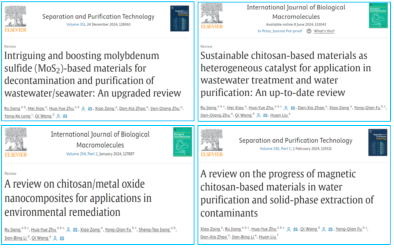Two review articles related to environmental water treatment materials written by Dr. Jiang Ru from the School of Life Sciences were accepted by the International Journal of Separation and Purification Technology, a top-tier engineering journal of the Chinese Academy of Sciences, and the International Journal of Biological Macromolecules, a top-tier chemistry journal of the Chinese Academy of Sciences. These are the third and fourth review articles that Dr. Jiang has published in the top journals of the Chinese Academy of Sciences this year. The four review articles focus on chitosan/metal oxides, magnetic chitosan materials, chitosan-based environmental catalysts, and molybdenum sulfide-based environmental functional materials.
Since 2009, Dr. Jiang has been working in the fields of pollution control and environmental functional materials for reduction for a long time. She has conducted a series of research with domestic and foreign collaborators on biomass-based environmental catalytic materials, magnetic biological adsorption materials, and metal sulfide catalytic materials. The relevant research results have been published as the first author or corresponding author in international TOP journals such as Chem Eng J, J Hazard Mater, Bioresour Technol, Carbohyd Polym, Desalination, Sep Purif Technol, and Ind Eng Chem Res, and have been cited by more than 10,000 scholars worldwide. The research group of Dr. Jiang Ru published three research papers on chitosan biomimetic mineralized CdS catalyst, magnetic chitosan adsorbent and magnetic cellulose/carbon nanotube composite adsorbent, which were selected as ESI highly cited papers in 2013, achieving a breakthrough in the number of ESI highly cited papers for Taizhou University. Based on solid research in the early stage, Dr. Jiang has comprehensively reviewed and summarized the latest international research progress on chitosan/metal oxide composite materials, chitosan-based environmental catalytic materials, magnetic chitosan-based adsorption materials, metal molybdenum sulfide catalytic materials, and other topics. She has also provided a detailed overview of effective modification strategies for improving the effectiveness of wastewater treatment and water purification using these materials, and highlighted their applications in environmental fields such as pollutant adsorption, photocatalytic degradation and reduction, Fenton advanced oxidation, PMS/PS activation oxidation, wastewater desalination membrane filtration, and solar evaporation desalination. Finally, the gap between theoretical research and application, engineering challenges, future research directions and opportunities have been discussed and proposed. This series of reviews not only deepens the understanding of environmental functional materials and their role in environmental pollution control, but also provides references and inspiration for future research in related fields such as pollutant adsorption and enrichment, photocatalytic oxidation degradation of pollutants and reduction of metal ions, and seawater desalination.
The first completion/communication unit of this series of review articles is Taizhou University, and the cooperative units are Zhejiang Gongshang University, University of British Columbia (UBC) in Canada, and University of Northern British Columbia (UNBC) in Canada. The preliminary research work of this review has received strong support from the Key Laboratory of Plant Evolutionary Ecology and Conservation in Zhejiang Province, and funding from the National Natural Science Foundation of China (51208331, 21007044), the Zhejiang Provincial Natural Science Foundation (LTY21B070001, LY15E080002, LY14B070011), and the Taizhou Science and Technology Plan (1701hb02, 121KY05, and 22gya08).

Link to Paper 1:
https://www.sciencedirect.com/science/article/pii/S0141813024038480
Link to Paper 2:
https://www.sciencedirect.com/science/article/pii/S0141813023047864
Link to Paper 3:
https://www.sciencedirect.com/science/article/pii/S1383586623024292
Link to Paper 4:
https://www.sciencedirect.com/science/article/pii/S1383586624018021